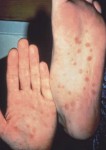 Syphilis is an ancient illness that was first described in the 15th century. It is a sexually transmitted disease caused by a bacteria called Treponema pallidum, and its occurrence is on the increase. Syphilis is a three-part disease. Primary Syphilis: This is the first stage of the disease; the only symptoms are a few painless skin ulcers (chancres). Secondary Syphilis:  This second stage begins two to eight weeks after the skin ulcers heal. The bacteria spread throughout the body, causing many types of rash, especially on the palms of the hands and the soles of the feet. These rashes can take on so many different appearances that the disease can occasionally be mistaken for something else, unless it is being diagnosed by a doctor. Other symptoms at this stage include fever, sore throat, swollen glands, and feeling miserable. Like with primary syphilis, the symptoms of secondary syphilis eventually disappear. Syphilis then goes dormant in the body for many years, except for the occasional flare-up of secondary symptoms. Tertiary Syphilis: The third stage of the disease, sometimes called late syphilis, may occur up to 15 years after the initial skin ulcers. The effects on the body slowly get worse and worse. Syphilis in this stage affects the brain and spinal cord, often causing mental illness and paralysis. It can also affect the aorta in the heart. Visible symptoms may also include rubbery lumps in the skin. Syphilis is spread by touching one of the skin ulcers or rashes, which are full of the bacteria. It can spread with protected or unprotected sex, and even without any sexual contact at all. Remarkably, Penicillin is still very effective at combatting this disease, and usually cures it. GONORRHEA | GENITAL WARTS | LICE & CRABS | SCABIES | HEPATITIS | HIV/AIDS |